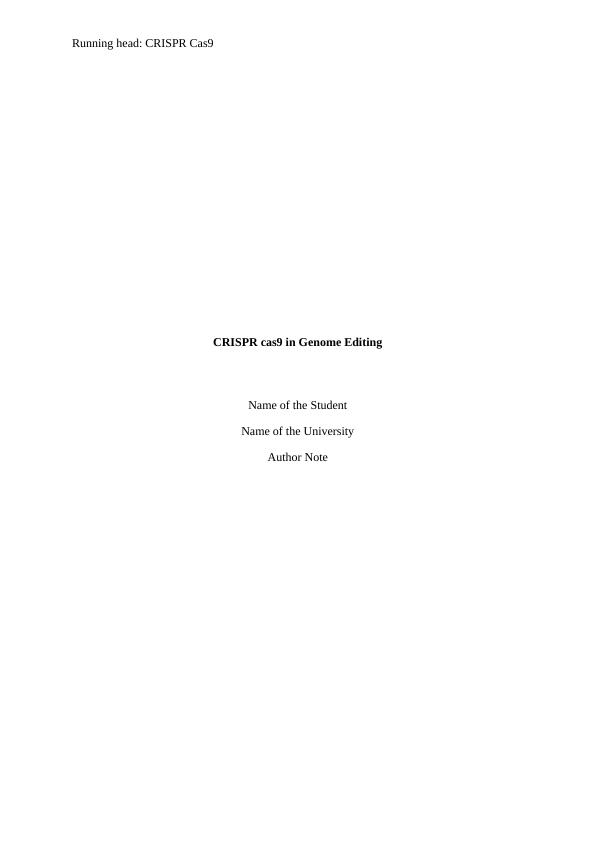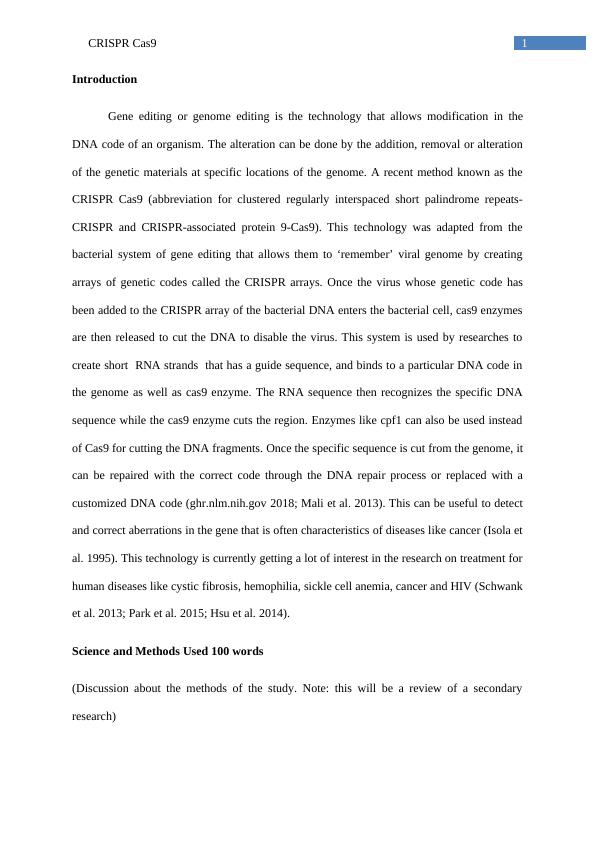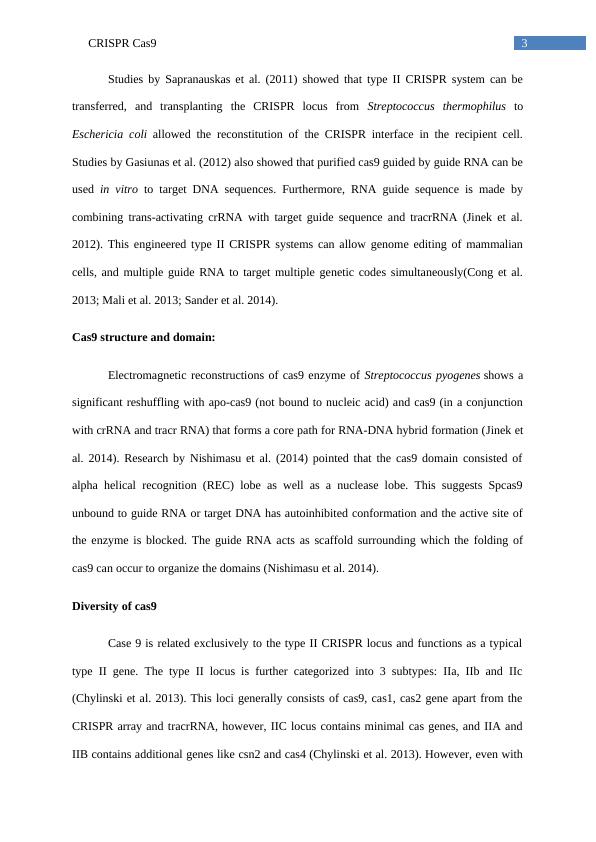Ask a question from expert
CRISPR cas9 in Genome Editing
13 Pages3614 Words43 Views
Added on 2021-04-22
CRISPR cas9 in Genome Editing
Added on 2021-04-22
BookmarkShareRelated Documents
Running head: CRISPR Cas9
CRISPR cas9 in Genome Editing
Name of the Student
Name of the University
Author Note
CRISPR cas9 in Genome Editing
Name of the Student
Name of the University
Author Note

1CRISPR Cas9
Introduction
Gene editing or genome editing is the technology that allows modification in the
DNA code of an organism. The alteration can be done by the addition, removal or alteration
of the genetic materials at specific locations of the genome. A recent method known as the
CRISPR Cas9 (abbreviation for clustered regularly interspaced short palindrome repeats-
CRISPR and CRISPR-associated protein 9-Cas9). This technology was adapted from the
bacterial system of gene editing that allows them to ‘remember’ viral genome by creating
arrays of genetic codes called the CRISPR arrays. Once the virus whose genetic code has
been added to the CRISPR array of the bacterial DNA enters the bacterial cell, cas9 enzymes
are then released to cut the DNA to disable the virus. This system is used by researches to
create short RNA strands that has a guide sequence, and binds to a particular DNA code in
the genome as well as cas9 enzyme. The RNA sequence then recognizes the specific DNA
sequence while the cas9 enzyme cuts the region. Enzymes like cpf1 can also be used instead
of Cas9 for cutting the DNA fragments. Once the specific sequence is cut from the genome, it
can be repaired with the correct code through the DNA repair process or replaced with a
customized DNA code (ghr.nlm.nih.gov 2018; Mali et al. 2013). This can be useful to detect
and correct aberrations in the gene that is often characteristics of diseases like cancer (Isola et
al. 1995). This technology is currently getting a lot of interest in the research on treatment for
human diseases like cystic fibrosis, hemophilia, sickle cell anemia, cancer and HIV (Schwank
et al. 2013; Park et al. 2015; Hsu et al. 2014).
Science and Methods Used 100 words
(Discussion about the methods of the study. Note: this will be a review of a secondary
research)
Introduction
Gene editing or genome editing is the technology that allows modification in the
DNA code of an organism. The alteration can be done by the addition, removal or alteration
of the genetic materials at specific locations of the genome. A recent method known as the
CRISPR Cas9 (abbreviation for clustered regularly interspaced short palindrome repeats-
CRISPR and CRISPR-associated protein 9-Cas9). This technology was adapted from the
bacterial system of gene editing that allows them to ‘remember’ viral genome by creating
arrays of genetic codes called the CRISPR arrays. Once the virus whose genetic code has
been added to the CRISPR array of the bacterial DNA enters the bacterial cell, cas9 enzymes
are then released to cut the DNA to disable the virus. This system is used by researches to
create short RNA strands that has a guide sequence, and binds to a particular DNA code in
the genome as well as cas9 enzyme. The RNA sequence then recognizes the specific DNA
sequence while the cas9 enzyme cuts the region. Enzymes like cpf1 can also be used instead
of Cas9 for cutting the DNA fragments. Once the specific sequence is cut from the genome, it
can be repaired with the correct code through the DNA repair process or replaced with a
customized DNA code (ghr.nlm.nih.gov 2018; Mali et al. 2013). This can be useful to detect
and correct aberrations in the gene that is often characteristics of diseases like cancer (Isola et
al. 1995). This technology is currently getting a lot of interest in the research on treatment for
human diseases like cystic fibrosis, hemophilia, sickle cell anemia, cancer and HIV (Schwank
et al. 2013; Park et al. 2015; Hsu et al. 2014).
Science and Methods Used 100 words
(Discussion about the methods of the study. Note: this will be a review of a secondary
research)

2CRISPR Cas9
The study by Hsu et al. (2014) analyzed the use of CRISPR cas9 genome editing
technology through secondary analysis of literature. Their studies discuss how CRISPR
technology can be used to design programmable nucleases, allow precise editing of the
genome, the structural architecture of Cas9, how this technique can be used in an eukaryotic
cell, how their recognition fidelity can be improved, and how the technology can be used in
research, medicine and biotechnology. The secondary research allows analysis of various
studies done on the topic to bring together a comprehensive understanding (Kothari 2004).
Data
Efficient and precise editing of genome using programmable nucleases:
Studies have shown that targeted double stranded breaks in the DNA can help genome
editing through homologous recombination (HR). Specific locus specific homologous
recombination (HR) has also been demonstrated using designer nucleases made from zinc
finger proteins (ZFP). Additionally, due to a lack of a template for repair for exogenous
homology, double stranded breaks can introduce deletions or insertions through non-
homologous pathways of joining of the ends (Hsu et al. 2014). Modifiable DNA binding
proteins like: zinc finger nuclease, transcription activator-like effectors (TALEs) and cas9
have been identified that can identify specific DNA sequences (Cong et al. 2013; Mali et al.
2013). The guide sequence in CRISPR array corresponds to the genomic sequence of the
phage, thereby providing antiviral resistance. Replacement of this sequence can then be made
with a sequence of interest, and thereby targeted by the cas9 nuclease. This customizable
DNA binding domain can allow modulation, as well as recruit desired changes like
transcriptional activation of a specific genetic locus (Mendenhall et al. 2013).
CRISPR cas 9 and Genome Editing:
The study by Hsu et al. (2014) analyzed the use of CRISPR cas9 genome editing
technology through secondary analysis of literature. Their studies discuss how CRISPR
technology can be used to design programmable nucleases, allow precise editing of the
genome, the structural architecture of Cas9, how this technique can be used in an eukaryotic
cell, how their recognition fidelity can be improved, and how the technology can be used in
research, medicine and biotechnology. The secondary research allows analysis of various
studies done on the topic to bring together a comprehensive understanding (Kothari 2004).
Data
Efficient and precise editing of genome using programmable nucleases:
Studies have shown that targeted double stranded breaks in the DNA can help genome
editing through homologous recombination (HR). Specific locus specific homologous
recombination (HR) has also been demonstrated using designer nucleases made from zinc
finger proteins (ZFP). Additionally, due to a lack of a template for repair for exogenous
homology, double stranded breaks can introduce deletions or insertions through non-
homologous pathways of joining of the ends (Hsu et al. 2014). Modifiable DNA binding
proteins like: zinc finger nuclease, transcription activator-like effectors (TALEs) and cas9
have been identified that can identify specific DNA sequences (Cong et al. 2013; Mali et al.
2013). The guide sequence in CRISPR array corresponds to the genomic sequence of the
phage, thereby providing antiviral resistance. Replacement of this sequence can then be made
with a sequence of interest, and thereby targeted by the cas9 nuclease. This customizable
DNA binding domain can allow modulation, as well as recruit desired changes like
transcriptional activation of a specific genetic locus (Mendenhall et al. 2013).
CRISPR cas 9 and Genome Editing:

3CRISPR Cas9
Studies by Sapranauskas et al. (2011) showed that type II CRISPR system can be
transferred, and transplanting the CRISPR locus from Streptococcus thermophilus to
Eschericia coli allowed the reconstitution of the CRISPR interface in the recipient cell.
Studies by Gasiunas et al. (2012) also showed that purified cas9 guided by guide RNA can be
used in vitro to target DNA sequences. Furthermore, RNA guide sequence is made by
combining trans-activating crRNA with target guide sequence and tracrRNA (Jinek et al.
2012). This engineered type II CRISPR systems can allow genome editing of mammalian
cells, and multiple guide RNA to target multiple genetic codes simultaneously(Cong et al.
2013; Mali et al. 2013; Sander et al. 2014).
Cas9 structure and domain:
Electromagnetic reconstructions of cas9 enzyme of Streptococcus pyogenes shows a
significant reshuffling with apo-cas9 (not bound to nucleic acid) and cas9 (in a conjunction
with crRNA and tracr RNA) that forms a core path for RNA-DNA hybrid formation (Jinek et
al. 2014). Research by Nishimasu et al. (2014) pointed that the cas9 domain consisted of
alpha helical recognition (REC) lobe as well as a nuclease lobe. This suggests Spcas9
unbound to guide RNA or target DNA has autoinhibited conformation and the active site of
the enzyme is blocked. The guide RNA acts as scaffold surrounding which the folding of
cas9 can occur to organize the domains (Nishimasu et al. 2014).
Diversity of cas9
Case 9 is related exclusively to the type II CRISPR locus and functions as a typical
type II gene. The type II locus is further categorized into 3 subtypes: IIa, IIb and IIc
(Chylinski et al. 2013). This loci generally consists of cas9, cas1, cas2 gene apart from the
CRISPR array and tracrRNA, however, IIC locus contains minimal cas genes, and IIA and
IIB contains additional genes like csn2 and cas4 (Chylinski et al. 2013). However, even with
Studies by Sapranauskas et al. (2011) showed that type II CRISPR system can be
transferred, and transplanting the CRISPR locus from Streptococcus thermophilus to
Eschericia coli allowed the reconstitution of the CRISPR interface in the recipient cell.
Studies by Gasiunas et al. (2012) also showed that purified cas9 guided by guide RNA can be
used in vitro to target DNA sequences. Furthermore, RNA guide sequence is made by
combining trans-activating crRNA with target guide sequence and tracrRNA (Jinek et al.
2012). This engineered type II CRISPR systems can allow genome editing of mammalian
cells, and multiple guide RNA to target multiple genetic codes simultaneously(Cong et al.
2013; Mali et al. 2013; Sander et al. 2014).
Cas9 structure and domain:
Electromagnetic reconstructions of cas9 enzyme of Streptococcus pyogenes shows a
significant reshuffling with apo-cas9 (not bound to nucleic acid) and cas9 (in a conjunction
with crRNA and tracr RNA) that forms a core path for RNA-DNA hybrid formation (Jinek et
al. 2014). Research by Nishimasu et al. (2014) pointed that the cas9 domain consisted of
alpha helical recognition (REC) lobe as well as a nuclease lobe. This suggests Spcas9
unbound to guide RNA or target DNA has autoinhibited conformation and the active site of
the enzyme is blocked. The guide RNA acts as scaffold surrounding which the folding of
cas9 can occur to organize the domains (Nishimasu et al. 2014).
Diversity of cas9
Case 9 is related exclusively to the type II CRISPR locus and functions as a typical
type II gene. The type II locus is further categorized into 3 subtypes: IIa, IIb and IIc
(Chylinski et al. 2013). This loci generally consists of cas9, cas1, cas2 gene apart from the
CRISPR array and tracrRNA, however, IIC locus contains minimal cas genes, and IIA and
IIB contains additional genes like csn2 and cas4 (Chylinski et al. 2013). However, even with

End of preview
Want to access all the pages? Upload your documents or become a member.
Related Documents
CRISPR Gene Editinglg...
|9
|1979
|467
CRISPR Gene Editing Research in Geneticslg...
|16
|4555
|199
Genetic Techniques and Ethical Considerationslg...
|7
|1867
|396
Lab Report University Name Studentlg...
|5
|1233
|20
Assignment | MODERN BIOTECHNOLOGYlg...
|25
|6727
|17
Gene Silencing Machinery in Eukaryoteslg...
|8
|1301
|64